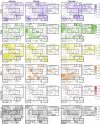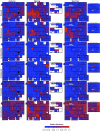Mapping microbial ecosystems and spoilage-gene flow in breweries highlights patterns of contamination and resistance
- PMID: 25756611
- PMCID: PMC4352708
- DOI: 10.7554/eLife.04634
Mapping microbial ecosystems and spoilage-gene flow in breweries highlights patterns of contamination and resistance
Abstract
Distinct microbial ecosystems have evolved to meet the challenges of indoor environments, shaping the microbial communities that interact most with modern human activities. Microbial transmission in food-processing facilities has an enormous impact on the qualities and healthfulness of foods, beneficially or detrimentally interacting with food products. To explore modes of microbial transmission and spoilage-gene frequency in a commercial food-production scenario, we profiled hop-resistance gene frequencies and bacterial and fungal communities in a brewery. We employed a Bayesian approach for predicting routes of contamination, revealing critical control points for microbial management. Physically mapping microbial populations over time illustrates patterns of dispersal and identifies potential contaminant reservoirs within this environment. Habitual exposure to beer is associated with increased abundance of spoilage genes, predicting greater contamination risk. Elucidating the genetic landscapes of indoor environments poses important practical implications for food-production systems and these concepts are translatable to other built environments.
Keywords: beer; built environment; droplet digital PCR; ecology; food fermentation; infectious disease; microbiology; next-generation sequencing; none.
Conflict of interest statement
The authors declare that no competing interests exist.
Figures









Similar articles
-
Beer spoilage bacteria and hop resistance.Int J Food Microbiol. 2003 Dec 31;89(2-3):105-24. doi: 10.1016/s0168-1605(03)00153-3. Int J Food Microbiol. 2003. PMID: 14623377 Review.
-
Beer spoilage lactic acid bacteria from craft brewery microbiota: Microbiological quality and food safety.Food Res Int. 2020 Dec;138(Pt A):109762. doi: 10.1016/j.foodres.2020.109762. Epub 2020 Oct 6. Food Res Int. 2020. PMID: 33292943
-
Isolation of a hop-sensitive variant of Lactobacillus lindneri and identification of genetic markers for beer spoilage ability of lactic acid bacteria.Appl Environ Microbiol. 2005 Sep;71(9):5089-97. doi: 10.1128/AEM.71.9.5089-5097.2005. Appl Environ Microbiol. 2005. PMID: 16151091 Free PMC article.
-
Microbial Communities in Retail Draft Beers and the Biofilms They Produce.Microbiol Spectr. 2021 Dec 22;9(3):e0140421. doi: 10.1128/Spectrum.01404-21. Epub 2021 Dec 22. Microbiol Spectr. 2021. PMID: 34935420 Free PMC article.
-
Pectinatus spp. - Unpleasant and recurrent brewing spoilage bacteria.Int J Food Microbiol. 2021 Jan 2;336:108900. doi: 10.1016/j.ijfoodmicro.2020.108900. Epub 2020 Oct 16. Int J Food Microbiol. 2021. PMID: 33129006 Review.
Cited by
-
Metagenomics insights into food fermentations.Microb Biotechnol. 2017 Jan;10(1):91-102. doi: 10.1111/1751-7915.12421. Epub 2016 Oct 6. Microb Biotechnol. 2017. PMID: 27709807 Free PMC article. Review.
-
A Review on the Applications of Next Generation Sequencing Technologies as Applied to Food-Related Microbiome Studies.Front Microbiol. 2017 Sep 21;8:1829. doi: 10.3389/fmicb.2017.01829. eCollection 2017. Front Microbiol. 2017. PMID: 29033905 Free PMC article. Review.
-
Distinct Microbiotas Are Associated with Different Production Lines in the Cutting Room of a Swine Slaughterhouse.Microorganisms. 2023 Jan 4;11(1):133. doi: 10.3390/microorganisms11010133. Microorganisms. 2023. PMID: 36677425 Free PMC article.
-
Next-generation sequencing approaches for improvement of lactic acid bacteria-fermented plant-based beverages.AIMS Microbiol. 2017 Jan 17;3(1):8-24. doi: 10.3934/microbiol.2017.1.8. eCollection 2017. AIMS Microbiol. 2017. PMID: 31294146 Free PMC article. Review.
-
The Interior Surfaces of Wooden Barrels Are an Additional Microbial Inoculation Source for Lambic Beer Production.Appl Environ Microbiol. 2018 Dec 13;85(1):e02226-18. doi: 10.1128/AEM.02226-18. Print 2019 Jan 1. Appl Environ Microbiol. 2018. PMID: 30389768 Free PMC article.
References
-
- Abarenkov K, Henrik Nilsson R, Larsson KH, Alexander IJ, Eberhardt U, Erland S, Høiland K, Kjøller R, Larsson E, Pennanen T, Sen R, Taylor AF, Tedersoo L, Ursing BM, Vrålstad T, Liimatainen K, Peintner U, Kõljalg U. The UNITE database for molecular identification of fungi - recent updates and future perspectives. New Phytologist. 2010;186:281–285. doi: 10.1111/j.1469-8137.2009.03160.x. - DOI - PubMed
-
- Abdo Z, Schüette UM, Bent SJ, Williams CJ, Forney LJ, Joyce P. Statistical methods for characterizing diversity of microbial communities by analysis of terminal restriction fragment length polymorphisms of 16S rRNA genes. Environmental Microbiology. 2006;8:929–938. doi: 10.1111/j.1462-2920.2005.00959.x. - DOI - PubMed
-
- Anderson MJ. A new method for non-parametric multivariate analysis of variance. Austral Ecology. 2001;26:32–46.
-
- Back W. Beer spoilage bacteria. Taxonomy of beer spoilage bacteria. Gram positive species. Monatsschr Brauwiss. 1981;34:267–276.

